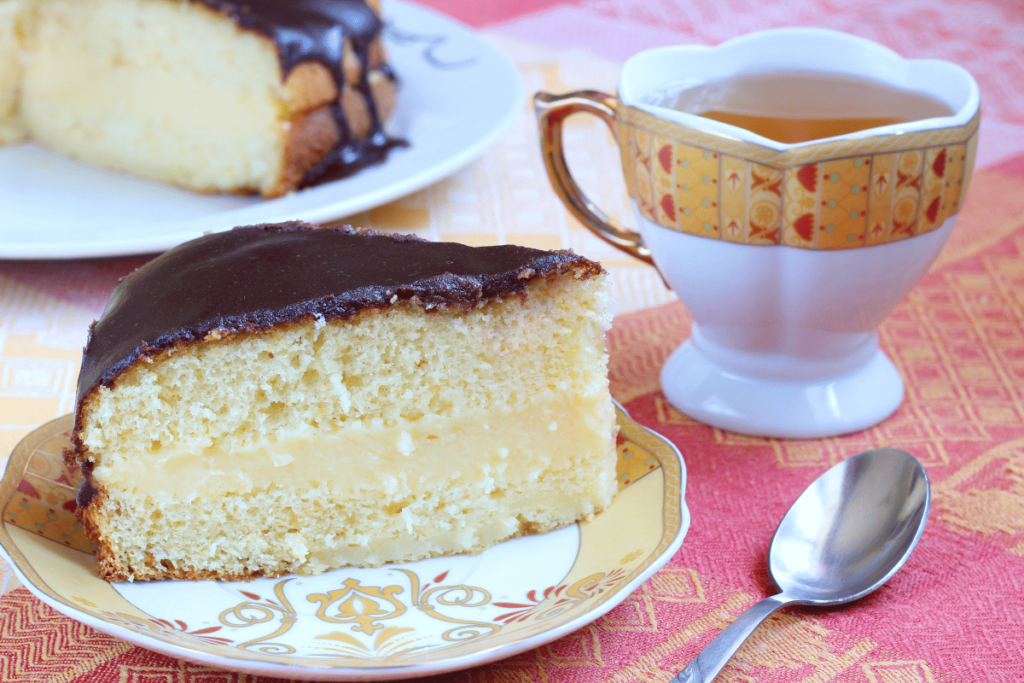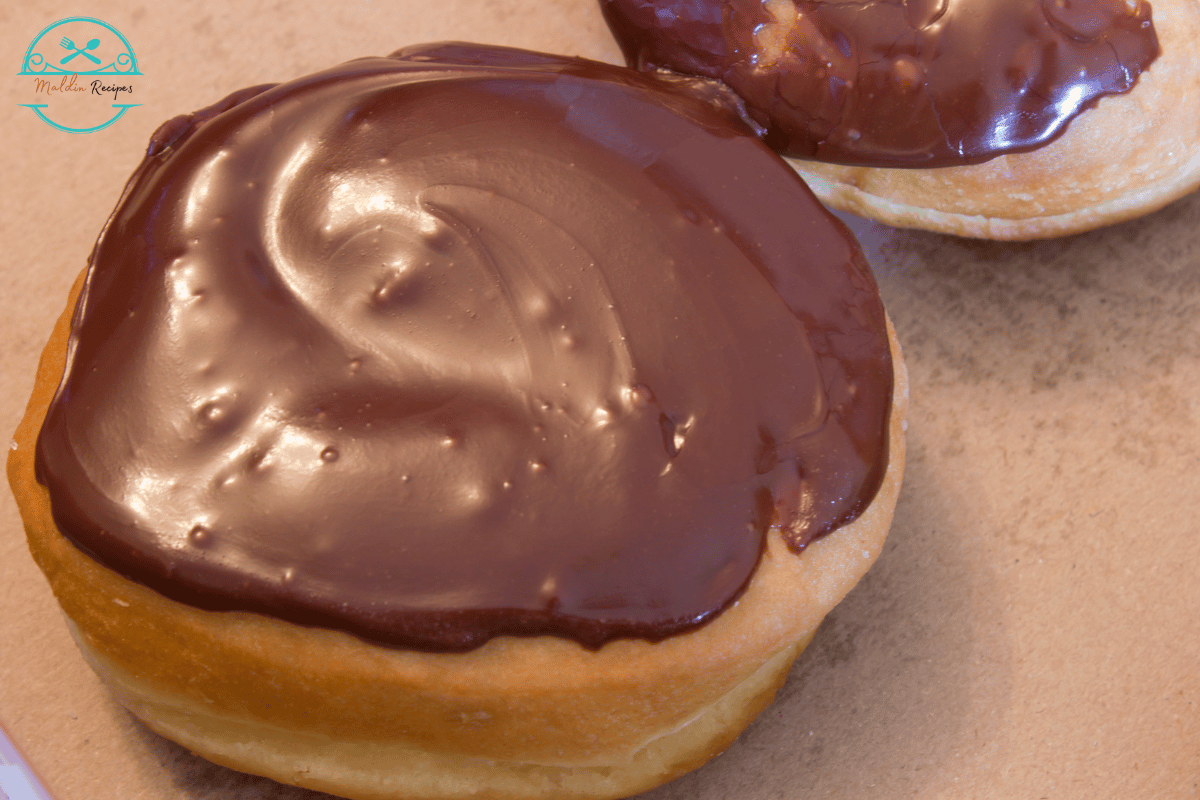Boston cream filling, a velvety mix, represents the rich culinary heritage of the U.S., especially Boston, Massachusetts. Known for its smooth texture and taste, it’s become a favorite in American desserts, featuring in pastries like the iconic Boston cream pie and popular Boston cream doughnuts.
The Origin of Boston Cream:
- Consider linking to the “Boston Cream Poke Cake Guide” page when discussing the history and origin of Boston cream. This can provide readers with a practical example of how Boston cream is used in modern recipes.
- Suggested sentence: “Boston cream filling’s fascinating origin in the mid-19th century is closely tied to the creation of the Boston cream pie, a unique cake crafted by French chefs at Boston’s Parker House Hotel. For a contemporary twist on this classic, check out our Boston Cream Poke Cake Guide.”
Why he is loved by many:
- After detailing why Boston cream filling is so beloved, you can link to a recipe that demonstrates its versatility, such as “Cinnamon Toast Crunch Apple Dump Cake,” even if it’s not directly related to Boston cream. The scope of the site displays dessert recipes.</span>
- Suggested sentence: “Its versatility shines in its ability to enhance a variety of desserts, from classic pies and donuts to éclairs and cakes. Discover another versatile dessert with the Cinnamon Toast Crunch Apple Dump Cake .”
What is the Boston creme filling made of?

Boston cream filling, the cornerstone of many beloved desserts, is known for its rich, creamy texture and delicate balance of sweetness. This classic custard is more than the sum of its parts; It is a culinary craft that combines simple ingredients to create a filling with great flavor and versatility. Let’s dive into the main ingredients that make up Boston cream filling and explore the critical role each ingredient plays in achieving its distinctive flavor and consistency.
Main components
Creating Boston cream filling revolves around a few basic ingredients, each chosen for their contribution to the overall texture and taste of the filling. These components include:
- Milk: Often whole milk is used for its richness, serving as the base of the custard and providing a creamy texture.
- Sugar: Adds sweetness to the custard, balancing the flavors and enhancing the overall taste.
- Eggs: Specifically, egg yolks are used for thickening the custard, lending it a rich color and a smooth, velvety texture.
- Cornstarch: Acts as a thickening agent, helping to stabilize the custard and ensure it has the right consistency.
- Vanilla Extract: Infuses the custard with its distinctive aroma and flavor, giving the Boston cream filling its characteristic taste
- . Butter: A small amount may be added to finish the custard, providing a silky, rich mouthfeel and rounding out the flavors.
The role of each component
- Milk: The foundation of the custard, milk’s role is to provide a creamy liquid base that carries the other flavors. The fat content in whole milk contributes to the custard’s rich texture and depth of flavor, making it an indispensable ingredient in achieving the perfect consistency. Sugar: Sugar does more than just sweeten the custard; it also affects the texture. By interacting with the proteins in the milk and eggs, sugar helps prevent the custard from becoming too firm, ensuring a smooth, creamy filling that’s neither too sweet nor too bland. Eggs: Egg yolks are crucial for thickening the custard to the right consistency. They contain lecithin, a natural emulsifier, which helps bind the milk and water content in the custard, preventing separation. The yolks also contribute to the rich color and flavor of the filling. Cornstarch: Cornstarch is a key thickening agent that works in tandem with the eggs to set the custard. It ensures the filling is firm enough to hold its shape when used in desserts, without compromising its creamy texture. Vanilla Extract: The essence of vanilla is what gives Boston cream filling its signature flavor. Vanilla extract adds depth and warmth to the custard, complementing the sweetness and richness of the other ingredients. Butter: Added at the end of the cooking process, butter enhances the custard’s richness and lends a glossy sheen to the filling. It smooths out the flavors, ensuring the filling is not just tasty but also has a luxurious mouthfeel.
The culinary journey of Boston cream filling
The story of Boston cream filling is a captivating culinary twist , tracing its roots back to Europe to become an American classic. This journey shows how recipes can adapt across cultures and innovate in American cuisine. We’ll explore the transformation of Boston cream filling from French influences to American classics, as well as a guide on creating this popular custard.
From French influence to American classics
The origins of Boston cream filling date back to the 19th century, and are associated with French-inspired pastry chefs in the United States. Its precursor, crème patissière, a staple of French bread, is used in many pastries such as éclairs and fruit tarts. This custard-like cream came to America with French chefs known worldwide for their culinary skills.

Upon their arrival in Boston, these chefs began adapting their traditional recipes to suit the tastes and ingredients available in their new environment. The result was a unique version of crème patissiere, which was used as a filling for the dish Boston Cream Pie – a dessert that, despite its name, is actually a cake. This creation featured layers of sponge cake filled with custard and covered in chocolate glaze, a combination that quickly became a favorite among locals.
Adapting French custard into what we now know as Boston cream filling is a testament to the melting pot of cultures that defines American cuisine. It represents a combination of sophistication and simplicity, combining the refined techniques of French pastry making with the straightforward, straightforward approach that characterizes American baking. Over time, Boston cream filling has become an integral part of the US culinary scene, and has evolved into a symbol of Boston’s rich history and culinary traditions.
How it’s made: a step-by-step guide
Crafting Boston cream filling from scratch is not just a process but a rewarding culinary adventure that requires precision and care. Here is a step-by-step guide to preparing this delicious custard:
<img class=”wp-image-329 size-full” src=”https://maldinrecipes.com/wp-content/uploads/2024/02/Capture-decran-2024-02-22-001947-1.png ” alt=”What is the Boston creme filling made of?” width=”996″ height=”637″ /> What is Boston cream filling made of? Width = “996
- Gather ingredients:
- 2 cups full fat milk
- 1/2 cup sugar
- 4 egg yolks
- A quarter cup of cornstarch
- a pinch of salt
- 1 teaspoon of vanilla extract
- 2 tablespoons unsalted butter
- Heating the milk: Start by heating the milk in a saucepan over medium heat until it is about to boil. Be careful not to let it boil.
- Mix the egg yolks and sugar: In a separate bowl, beat the egg yolks and sugar together until light and fluffy. Then, add the cornstarch and salt, and mix until smooth.
- Dilute the egg mixture: Gradually add about a cup of hot milk to the egg mixture, and whisk constantly. This step softens the eggs and prevents them from curdling when served with hot milk.
- Mix and cook: Pour the beaten egg mixture back into the pot with the remaining milk, whisking constantly. Cook over medium heat until the mixture thickens and reaches a custard-like consistency, usually about 5 to 7 minutes. Stir constantly to prevent lumps from forming.
- Finishing touches: Once the custard has thickened, remove from the heat and stir in the vanilla extract and butter until fully incorporated and the custard is smooth.
- Cool and use: Transfer the custard to a bowl, cover with plastic wrap, and press directly onto the surface to prevent a skin from forming. Place it in the refrigerator until it cools completely and is ready for use.
Exploring texture and flavor
The appeal of Boston Cream The filling extends far beyond its rich history, playing a pivotal role in famous desserts through its exceptional texture and flavour. This custard filling is a staple of our beloved Boston Cream Pie and many other desserts, offering a luxurious and comforting sensory experience. Let’s delve into the aspects that make up the texture and flavor of an irresistible Boston creme filling : the silky softness of custard and the sweet balance between sugar and vanilla.
The silky smoothness of custard
Boston Cream Filling texture is defined and attractive. The perfect custard texture – silky, smooth, holds its shape, but melts in the mouth – shows the culinary skill involved. This texture comes from carefully combining the milk, sugar and eggs and cooking them, adding cornstarch to ensure proper setting without being too hard.
The secret to this silky softness lies in preparing the custard. The process involves gently heating the milk and sugar, then slowly adding the beaten egg yolks, ensuring the mixture thickens without curdling. <span style=”vertical-align: inherit;”>Continuous stirring is essential to prevent the eggs from scrambling and to ensure the mixture cooks evenly, resulting in a velvety, smooth custard. Adding butter at the end of the cooking process adds an extra layer of richness, enhancing the luxurious texture of the custard.
Sweet balance of sugar and vanilla
The flavor of the Boston cream filling is just as important as its texture, which has a subtle sweetness that’s not overpowering or too subtle.
The balance of sugar in the custard is carefully measured to complement the natural richness of the milk and eggs, ensuring the filling remains a perfect counterpart to the cakes, donuts and pastries that accompany it.
Vanilla plays a pivotal role in determining the flavor of the Boston cream filling. Using high-quality vanilla or bean extract gives the custard a warm, floral flavor, elevating the filling. Vanilla adds depth and complexity, enhancing the sweetness of the sugar for a blend that is comforting, familiar and sophisticated.
Variations on Boston cream filling
Vegetarian options
Creating a vegan version of Boston cream filling involves replacing animal ingredients with plant-based alternatives. The challenge is to replicate the creamy texture and rich flavor without using eggs, milk or butter. Here’s how it’s done:
- Milk: Plant milk such as almond, soy, or coconut milk can be used as an alternative to cow’s milk. Each brings its own unique flavor and richness, with the coconut milk offering a particularly creamy texture that works well with custard fillings.
- Eggs: To achieve the thickening effect that eggs provide in traditional custards, vegetarian versions often rely on cornstarch or agar agar. These ingredients help thicken the mixture to reach the desired consistency without the need for eggs.
- Butter: Vegan butter or refined coconut oil can be used in place of dairy butter to add richness and softness to the filling.
- Sugar: It’s important to use vegan-friendly sugar, processed without animal bones, to ensure the filling is completely vegan.
Gluten-free options
For those who avoid gluten, the main concern with traditional Boston cream filling is the use of flour or cornstarch as a thickening agent. To make a gluten-free version, one must choose ingredients that do not contain gluten:
- Thickening Agents: Pure cornstarch is naturally gluten-free and can be used safely. However, for those who avoid cornstarch, alternatives such as arrowroot powder or gluten-free flour blends can serve as effective thickeners.
- Cross-contamination: Make sure all ingredients, including vanilla extract and plant milk, are certified gluten-free to prevent cross-contamination.
Sure, with the right ingredients and a little creativity, vegan and gluten-free versions of Boston cream can be just as delicious as the traditional recipe. This ensures that everyone can enjoy this delicious treat, regardless of dietary preferences or restrictions.
Pairing with other desserts
The best desserts to complement Boston Cream
The Boston cream filling pairs beautifully with desserts contrasting with its smooth texture or complementing the rich flavors of vanilla and custard. Here are some top picks:
- Chocolate Eclair : Airy choux pastry with rich Boston cream and a glossy chocolate glaze. The bitterness of the chocolate offsets the sweetness of the filling.
- Layer Cake : Vanilla cake or buttercream cake with a layer of Boston icing and iced with chocolate ganache or vanilla buttercream frosting. The lightness of the cake complements the creamy filling.
- Fruit Tart : A crispy tart crust filled with Boston creme and topped with fresh fruit. The acidity of the fruit balances the richness of the cream.
- Coffee or tea : Not a dessert, but its flavors can complement the sweetness of Boston’s creamy pastries. Perfect for an afternoon treat.
Creative presentation ideas
Boston cream filling can be used creatively in various desserts:
- Boston Cream Pies : Pies topped with Boston cream and topped with chocolate drizzle.
- Boston Cream Cupcakes : Cupcakes filled with custard and topped with a rich chocolate glaze.
- Deconstructed Boston Cream Pie : Serve the Boston cream, crumbled sponge cake, and chocolate sauce separately for a modern twist.
- Boston Crème Parfait : Layer filled with crumbled biscuits or cake and chocolate ganache in clear cups.
- Boston Cream Donut Trifle : A layer of cubed Boston Cream donuts with extra filling and chocolate sauce.
Pro tips for getting the perfect Boston cream
It is an art that balances science and culinary skill. Experienced pastry chefs share ideas to improve your home cooking endeavors. Here are the secrets to flawless Boston cream filling and common mistakes to avoid.
Secrets of pastry chefs
- Temperature Control: The perfect custard consistency requires precise temperature control. Pastry chefs recommend mixing the egg yolks with the hot milk, then combining everything to prevent the eggs from scrambling.
- Strain to fineness: After cooking, strain the custard through a fine mesh sieve. This step removes any bits or clumps of cooked egg to ensure the filling is completely smooth
- Flavor mixture: To add flavour, heat the milk with the vanilla beans and let stand before preparing the custard. This maximizes the vanilla flavor for a deeper aromatic taste.
- Butter for richness: Adding a little butter to cooked custard enhances richness and gloss. Stir until completely dissolved and mixed.
- Chill properly: Allow the custard to cool before covering it with plastic wrap directly on the surface. This prevents a skin from forming on top and ensures the custard remains soft
Common mistakes to avoid
- Speed up the process: Patience is crucial when making Boston cream filling. Rushing the cooking process can result in the filling being either too runny or too thick. Cook the custard over medium-low heat and allow it to gradually thicken.
- Overcooking custard: Overcooking custard can make it rough and grainy. Watch it closely and remove it from the heat when it coats the spoon.
- Skip the strain: Failing to strain the custard may leave you with a lumpy filling. Always strain to ensure a silky texture
- Not cooling completely: Using the filling while it is still warm may cause the desserts to become soggy. Make sure the custard is completely cooled to room temperature and then refrigerate it before using.
- Forgetting to cover: If the custard cools uncovered, it will form a crust, which spoils its texture. Make sure the plastic wrap is in direct contact with the custard to retain moisture.
Conclusion:
The enduring popularity of Boston Cream
Its blend of milk, sugar, eggs and vanilla provides a luxurious, comforting taste and promotes culinary innovation.
This has led to adaptations such as vegan and gluten-free versions, broadening its appeal and demonstrating a commitment to inclusivity.
Its cultural significance, symbolized by its status as the official dessert of Massachusetts, highlights its role in blending culinary innovation with tradition.
Sophisticated yet classic, Boston Cream’s enduring popularity, timeless charm, and adaptability make it a joyful part of the American dessert scene.

